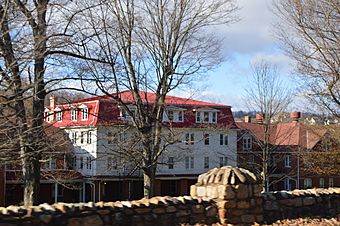Massanetta Springs Historic District facts for kids
|
Massanetta Springs Historic District
|
|

Front of the hotel
|
|
| Location | 712 Massanetta Springs Rd., Harrisonburg, Virginia |
|---|---|
| Area | 70 acres (28 ha) |
| Built | 1816 |
| Built by | Fred K. Betts (camp) Heatwole & Hedrick (lodge & church) Sam Shrum (hotel addition) |
| Architect | W. Glen Wallace (camp) Joseph Nielsen (hotel addition) |
| Lot planner | Charles F. Gillette |
| Architectural style | Second Empire, Queen Anne |
| NRHP reference No. | 05000477 |
Quick facts for kids Significant dates |
|
| Added to NRHP | May 26, 2005 |
The Massanetta Springs Historic District is a special retreat in Rockingham County, Virginia. It is managed by the Presbyterian Synod of Virginia. This place is mostly known for the Massanetta Springs Summer Bible Conference Encampment.
The district includes the main Hotel (built in 1910), the Hudson Auditorium (from 1922), and Camp Massanetta (built in 1955–56). A Methodist camp first started here in 1816. Back then, the area was known as Taylor's Springs.
Contents
History of Massanetta Springs
The first person to settle in this area was James Taylor. He built a house here after 1730. Around 1816, Jonathan and William Taylor rented the land. They leased it to the Rockingham Circuit of the Methodist Episcopal Church. It was used as a place for large outdoor religious meetings called camp meetings.
These yearly meetings became very popular. People also believed the springs had healing powers. Evan Henton owned the springs in the late 1840s. He ran a small spa there. In the 1870s, a group tried to rename the property "Ague and Healing Springs."
Dr. Burke Chrisman built a house there in 1885. He also built a hotel. By 1893, the area was known as Massanetta Springs. This name combines "Massanutten," a local place, and "Henrietta," Dr. Chrisman's wife's name. Dr. Chrisman sold water from the springs all over the country. He called it "Massanetta Spring Water."
New Owners and Changes
After Dr. Chrisman passed away in 1909, a banker named James Robert Lupton bought the property. He started building a new brick hotel at the springs. In 1912, he sold the property to the Massanetta Springs Company. But he took it back in 1919.
Later that year, Lupton and his wife sold the resort to Hampden-Sydney College. The college planned to use it as a Presbyterian boarding school. However, by 1920, the idea of an academy was not as popular. So, in 1923, the college gave ownership to the Presbyterian Synod.
The synod started running the resort as a religious retreat again. They built an open-air building called the Hudson Auditorium. Many different Christian groups used Massanetta for conferences. These included Methodist, Baptist, and Lutheran groups. In the 1930s, there was a brief idea to use the property for a school again, but it was not carried out. From 1931 to 1939, the Massanetta Music School held festivals for church choirs.
Adding More Buildings
Starting in 1925, many small cottages were built near "The Grove." Eventually, there were 41 privately owned cottages. These cottages are not part of the historic district.
In 1947, the Richardson Building was added. It was an army surplus building used for more guest rooms. In 1962, it was updated and got a second floor. This made it look like a motel. Because of these changes, it is not included in the historic district.
In the mid-1950s, Camp Massanetta was built on a hill west of the main area. An architect named W. Glen Wallace designed the campground. It included sixteen cabins, lodges, a dining hall, and a swimming pool. All these were finished in 1956. There were also places for tents in the nearby woods. In 2001, a building called the New Lodge was added.
What Massanetta Springs Looks Like
The most important building in the district is the hotel. It is made of brick and wood. The hotel has four stories and a special kind of roof called a mansard roof. This style is known as Second Empire. The first floor is brick, and the second and third floors are covered in stucco. The top floor has a metal design. There is a porch at the front and back.
The inside of the hotel was partly updated in the 1950s. The main old part inside is a grand staircase.
Other Important Buildings
The Hudson Memorial Auditorium has a roof but is open on the sides. The first part was built in 1922. More classrooms were added in 1925, 1930, 1939, and around 1950. You can see the roof supports inside. The seats are attached to the floor, which slopes down to a stage. There are benches on the sides and bleachers at one end. Classrooms are located under the auditorium.
Other buildings include the Fannie Lupton Building. It is a simple, rustic building used for meetings. The Lucy Steele Memorial Prayer Room is a plain chapel made of concrete blocks. The Nook, built in 1957–58, is a bookstore and cafe made of reinforced concrete. The Springhouse protects the natural spring and its faucets.
Camp Massanetta is divided into four areas called "villages." These are labeled A, B, C, and D. The buildings are made of wood with rough siding. They have wide, overhanging roofs supported by diagonal beams, giving them a modern look. The insides are simple, with open roof structures. The Bell Auditorium is the main building in the camps. It also has the wide overhangs and diagonal supports. It is now used as a dining hall.
Massanetta Springs was added to the National Register of Historic Places on May 26, 2005.



